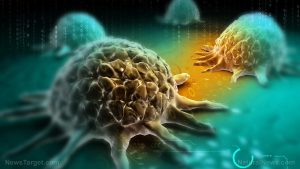
Chordoma – causes, side effects and treatments at NaturalPedia.com
Thursday, February 15, 2018 by Ralph Flores
http://www.naturalpedia.com/chordoma-causes-side-effects-and-treatments-at-naturalpedia-com.html

Chordomas (also referred to as CHDM, notochordal sarcoma, and notochordoma) are rare tumors that are found anywhere along the spine — in particular, they emerge from notochordal remnants, which are primitive backbones that provided support during embryonic development. These types of tumors account for less than one percent of all tumors in the central nervous system (CNS), and they rarely develop outside the spine.
Most cases of chordoma develop at the base of the spine (sacrum), but it can still occur in other areas such as the base of the skull, the neck, and the upper and lower back of the spine. The tumor growth is insidious; however, it can cause local destruction of the bone and nearby soft tissue. As it continues to grow, it also puts pressure on adjacent areas, which then causes the signs and symptoms to appear.
The likelihood of having chordomas is rare — only one in one million people will develop the condition.

Known risk factors and symptoms for chordoma
The etiology of chordoma is believed to come from changes in the TBXT gene, which is involved in embryonic development. The condition may also be an autosomal dominant, which means that parents who have a chordoma may pass the risk of getting the disorder to their children. However, further studies are needed to obtain clinical evidence.
A risk factor for developing chordomas is age — people between 40 to 70 years of age are more likely to have the condition. However, there have been cases wherein children were also affected by the disease. It also affects men more than females.
Chordomas grow very slowly; therefore, visible signs and symptoms are noted when the condition has already become quite large. A growth anywhere along the spine causes pain, while a chordoma located at the base of the skull (occipital chordoma) may lead to double vision (diplopia) and headaches, and one that is found in the tailbone (coccygeal chordoma) may result to a visible lump and problems with bladder and bowel function.
Other symptoms include visual loss, hearing loss, difficulty in swallowing, hoarse voice, facial numbness, incoordination, motor weakness and memory disturbance.
Body systems affected by chordoma
Chordoma primarily affects the CNS. The condition can metastasize to other areas — albeit rarely — but the main cause of mortality is tissue death in nearby areas.
Food items or nutrients that may prevent chordoma
Like other forms of cancer, diet constitutes a great deal in reducing the likelihood of developing chordoma. Here are some recommended food items to help against chordoma.
- Alkaline diet — The mutating cells that cause cancer thrive in an acidic environment; therefore, balancing your pH level helps reduce the likelihood of developing it. To start with an alkaline diet, avoid meats and eat leafy vegetables, lemons, limes, grapefruit, wheatgrass, almonds, sprouts, organic cold-pressed oils, and grains such as millet or quinoa.
- Apple cider vinegar — Taking one to two tablespoons diluted in eight ounces of water for at least twice a day ensures may boost the immune system.
- Baking soda — To help balance your body’s pH level, take one to two teaspoons diluted in six to eight ounces of water twice a day.
Also, try adding more carrots, grains, tomatoes, garlic, and fiber-rich foods in your diet to bolster your defenses against cancer.
Treatment and management options for chordoma
The courses of treatment for chordoma depend on where the tumor is and how big it has become. Moreover, the condition needs to be dealt with as soon as possible to reduce its chances of recurrence.
A person who has chordoma may need to undergo surgery to remove the tumor, which is followed up by radiotherapy to destroy remaining cells.
However, the condition may return to the same location after surgery or radiation. This means a person may have multiple surgeries to treat the recurring tumors.
Where to learn more
- Fight Tumor Re-Seeding with Natural Remedies
- Man’s tumor shrinks when he alters environment, shuns cancer treatments in favor of acts of kindness
- Brain tumor vanishes in ‘Miracle Baby’ after family chooses cannabinoid oil
- Woman goes to get tumor removed, discovers ‘evil twin’ lodged in her brain
- Halting tumor growth in its tracks through angiogenesis: Can it be done with simple foods on your grocery list?
Summary
Chordomas are cancerous tumors that occur anywhere in the spine. It is noted to develop slowly, but it can cause back pain and double vision, among its symptoms. Still, some foods can be consumed to prevent chordoma.
Sources include:
Tagged Under: Tags: chordoma





